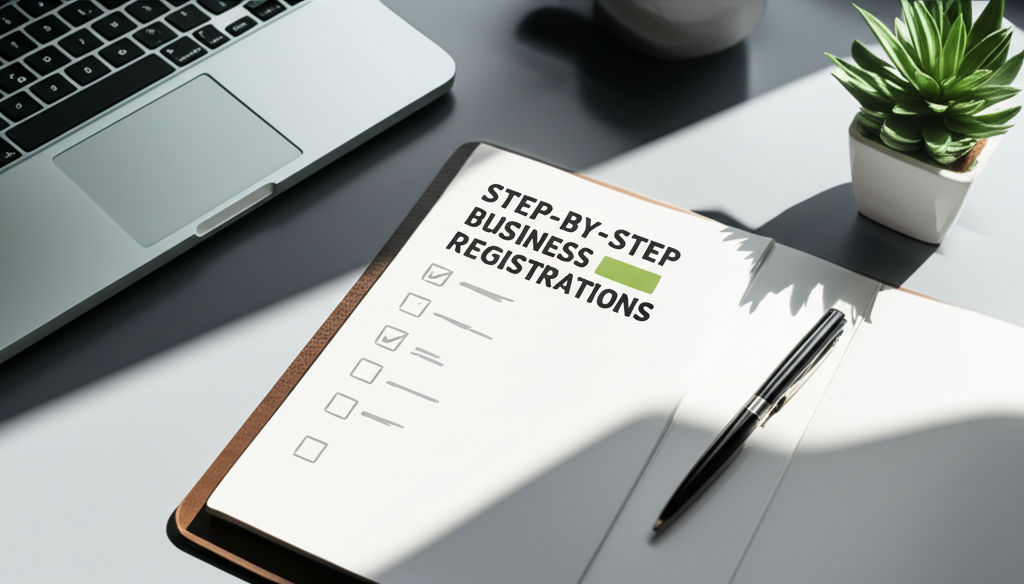Step-by-Step Business Registrations
Emily Willis

Photo: Step-by-Step Business Registrations
Starting a new business is an exciting journey, often filled with innovation and passion. However, before your groundbreaking idea can truly take flight, there’s a crucial foundational step that ensures its legitimacy and sets the stage for long-term success: business registration. This process, while seemingly bureaucratic, provides legal protection, enhances credibility, and unlocks various opportunities for growth and funding. Navigating the world of business registrations can feel complex, but with a clear, step-by-step approach, it becomes a manageable and empowering part of your entrepreneurial path.
This comprehensive guide will walk you through the essential stages of business registration, from choosing the right legal structure to understanding your ongoing compliance obligations. By the end, you’ll have a robust understanding of how to legally establish your venture, allowing you to focus on building your brand with confidence.
Understanding the 'Why' Behind Business Registration
Before diving into the "how," it's vital to grasp the fundamental reasons why proper business registration is non-negotiable. It's more than just a formality; it's a strategic move that safeguards your future.
Legal Protection and Liability
Perhaps the most significant benefit of registering your business, especially as a separate legal entity like an LLC or Corporation, is the protection of personal assets. Without proper registration, a sole proprietorship or general partnership means your personal assets (your home, savings, car) are not legally separate from your business. This means that in the event of business debts, lawsuits, or bankruptcy, your personal assets could be at risk. Registering a business as a distinct entity helps shield these personal assets from business liabilities.
Credibility and Trust
A registered business instantly gains a level of professionalism and credibility. When you approach potential clients, partners, or investors, a formally registered entity demonstrates your commitment and seriousness. For instance, clients may view an incorporated business as more professional and dependable, and lenders often require incorporation for business loans. It signals that your operation adheres to established legal frameworks, fostering trust and opening doors to more significant opportunities.
Access to Funding and Opportunities
Many financial institutions require a registered business entity and an Employer Identification Number (EIN) to open a business bank account or secure loans. Without these, accessing crucial funding for expansion, inventory, or operations becomes significantly harder. Furthermore, many government contracts, grants, and even some B2B partnerships are only available to formally registered businesses.
Tax Benefits and Compliance
Proper business registration ensures you comply with federal, state, and local tax laws. Different business structures offer varying tax implications, some of which can be highly beneficial. For example, some structures allow for pass-through taxation, where business profits are reported on the owner's personal income tax return, simplifying tax preparation. Understanding your registration status helps you navigate tax obligations correctly and potentially leverage deductions or rates that wouldn't be available otherwise.
Step-by-Step Business Registrations: Your Comprehensive Guide
The process of registering a business typically involves several key steps, varying slightly by location and the nature of your business. Generally, registering a company in the U.S. can take anywhere from a few days to several weeks, with an average of 1 to 3 weeks. States like Delaware, known for their business-friendly laws, may offer faster processing, especially with online systems.
Step 1: Choose Your Business Legal Structure
This is arguably the most critical initial decision, as it impacts liability, taxation, administrative burden, and your ability to raise capital. Each structure has its own set of pros and cons.
- Sole Proprietorship: The simplest and least costly structure, where the business and owner are legally the same entity. There's no legal separation, meaning the owner is personally liable for all business debts and obligations. This structure is common for freelancers, independent contractors, and home-based businesses in low-risk industries.
- Partnership: Similar to a sole proprietorship but involves two or more owners. It's easy to start, but all partners share personal liability for business debts. A well-drafted partnership agreement is highly advisable.
- Limited Liability Company (LLC): Offers personal liability protection for its owners (members), meaning only the company's assets are at risk if the business is sued or incurs debt. LLCs combine the liability protection of a corporation with the pass-through taxation benefits of a sole proprietorship or partnership, making them a popular choice for many small and growing businesses.
- Corporation (C-Corp, S-Corp): A separate legal entity from its owners (shareholders), offering the strongest personal liability protection. Corporations can raise capital more easily by issuing stock. However, they typically involve more complex setup, stricter record-keeping, and higher compliance requirements. C-corps face "double taxation" (corporate profits taxed, then dividends taxed at the shareholder level), while S-corps can avoid this by passing profits directly to shareholders.
Practical Tip: Consider your long-term goals, the level of liability you're comfortable with, and your tax situation. Consulting with a business attorney or accountant can provide invaluable guidance in making this decision.
Step 2: Register Your Business Name
Once you've decided on your business structure, securing your business name is paramount. This involves checking its availability and registering it with the appropriate authorities.
- Availability Check: Conduct a thorough search to ensure your chosen business name isn't already in use. This typically involves checking with your state's Secretary of State office and the U.S. Patent and Trademark Office (USPTO) for trademarks.
- "Doing Business As" (DBA): If you operate a sole proprietorship or partnership under a name different from your legal name, you'll likely need to file a "Doing Business As" (DBA) or "fictitious name" registration with your city or county. LLCs and corporations can also use a DBA to operate under a name different from their registered legal name.
- Formal Registration: For LLCs, corporations, and other formal entities, your business name is typically registered when you file your formation documents (e.g., Articles of Organization for an LLC, Articles of Incorporation for a Corporation) with the state's Secretary of State or equivalent office.
Actionable Insight: Don't skip the trademark search. A unique name protects your brand identity and prevents future legal disputes.
Step 3: Obtain Your Employer Identification Number (EIN)
An Employer Identification Number (EIN), also known as a Federal Tax Identification Number (FTIN), is a nine-digit number assigned by the IRS, essentially a Social Security number for your business.
- Who Needs an EIN? You'll need an EIN if you plan to hire employees, operate as a partnership, corporation, or multi-member LLC, or if you need to pay excise or employment taxes. Even if not strictly required for tax purposes (e.g., a sole proprietorship with no employees), obtaining an EIN is highly recommended.
- Why is it Needed? An EIN is crucial for opening a business bank account, filing tax returns, and applying for business licenses and permits.
- How to Apply: You can apply for an EIN for free directly from the IRS online. This is generally the fastest method, providing your EIN immediately upon application. You can also apply by fax or mail, though these methods take longer (around 4 business days for fax, 4-6 weeks for mail).
Tip: Be wary of third-party services that charge for EIN application, as it's a free service from the IRS.
Step 4: Register with Your State and Local Governments
After obtaining your EIN, the next crucial step is to register your business with relevant state and local agencies.
- State-Level Registration:
- Secretary of State (or equivalent): If you formed an LLC, corporation, or partnership, you must file formation documents with your state's Secretary of State or a similar business registration division. This officially legitimizes your business to operate within that state.
- State Tax IDs: Depending on your business activities (e.g., selling products, having employees), you may need to register for state-specific tax IDs, such as sales tax permits or state payroll tax accounts.
- Local-Level Registration:
- City/County Business Licenses: Most businesses require a general business license from the city or county where they are located, even if it's a home-based business. This license often serves as a tax registration certificate, granting legal approval to conduct business in the area.
- Local Permits: You may also need specific local permits, such as zoning permits, health permits (for food-related businesses), or signage permits, depending on your industry and location.
Example: A
Latest ✨
View AllRevolutionize your learning! Data analytics is the future of education, enabling personalized paths & unlocking individual potential.
Emily Willis
Cloud computing is essential for modern businesses, offering cost savings, scalability, and improved collaboration. Implementing cloud computing requires careful planning to ensure safety and efficiency. Tips for safe and efficient implementation include conducting a needs assessment, choosing the right cloud service model, prioritizing security, planning for data migration, optimizing costs, training your team, implementing backup and recovery solutions, monitoring performance, planning for scalability, and staying updated with industry trends.
Emily Willis
effective leadership in a constantly changing world and explores the traits and habits of inspiring leaders, both historical and contemporary. It highlights the key lessons from leaders such as Nelson Mandela, Martin Luther King Jr., Jacinda Ardern, Elon Musk, and Malala Yousafzai.
Emily Willis
Customer feedback is a goldmine for business growth. Learn how leveraging insights enhances products, builds loyalty, and keeps you competitive.
Emily Willis
Business
View All
June 9, 2025
Cloud Computing for Small BusinessUnlock growth & efficiency! Discover how cloud computing empowers small businesses with cost savings & agility in the digital age.
Emily Willis

June 9, 2025
Customer Retention Strategies That WorkUnlock lasting success! Learn proven customer retention strategies to build loyalty, reduce churn, and boost your business growth.
Emily Willis

June 8, 2025
Strategic Planning for Long-Term WinsChart your course to enduring success! This article demystifies strategic planning, offering an actionable framework for long-term wins and sustainable growth.
Emily Willis
Economy
View AllBoost your business profits! Discover actionable strategies to maximize revenue and efficiently manage costs for sustainable growth.
Read MoreUnpack the 17 Sustainable Development Goals (SDGs): a global blueprint addressing poverty, climate change, and inequality for a sustainable future.
Read MoreThe COVID-19 pandemic has had a significant impact on the global economy, leading to market turmoil, disrupted supply chains, and widespread business closures. As countries slowly recover, there are questions about the future of the global economy. While there are signs of recovery, challenges such as rising inflation, uneven global recovery, labor market disruptions, and supply chain bottlenecks remain. To ensure a sustainable recovery, policymakers must continue to support vulnerable sectors, invest in education and reskilling, strengthen healthcare systems, promote supply chain resilience, address inequalities, and prioritize sustainability.
Read MoreEntertainment
View All
August 4, 2024
The Latest Music Trends, Artists Influencing Pop Culture, and How Digital Platforms Facilitate the Distribution of Music GloballyThe music industry is constantly changing due to consumer preferences, technology, and the influence of artists. Digital platforms have revolutionized music creation, distribution, and consumption, leading to genre fusion, the rise of independent artists, and collaborative projects. Influential artists like Billie Eilish, BTS, and Taylor Swift have shaped pop culture globally. Streaming services, social media, and direct-to-fan engagement have transformed music distribution. Digital platforms also promote cultural diversity and inclusivity, expand markets and revenue, and drive technological advancements. The industry is also focusing on sustainability and ethical practices. To succeed in the future, stakeholders must embrace digital transformation and champion inclusivity.
Emily Willis

August 4, 2024
The Evolution of Streaming Services Such as Netflix, Disney+, Hulu, and the Implications for the Traditional Entertainment IndustryThe rise of streaming services has revolutionized the entertainment industry, offering on-demand access to a vast library of content through internet-connected devices. Platforms like Netflix, Disney+, and Hulu have diversified their content libraries, reshaped consumer behavior, and challenged traditional distribution models. Technological advancements have enhanced streaming experiences, while economic and cultural implications have led to global market expansion and increased investment in original content production. The future of the streaming industry will be shaped by competition, convergence of media and technology, and the need for adaptation to changing consumer preferences. Embracing digital transformation and strategic partnerships will be crucial for stakeholders in navigating the evolving landscape of modern entertainment.
Emily Willis

August 5, 2024
Entertainment in Society: Social Impact, Cultural Influence, Economic ContributionsEntertainment is more than just a way to pass the time it has a significant impact on society, culture, and the economy. It promotes empathy, sparks conversations, and drives social change. It reflects and shapes cultural trends, while also preserving traditions. The entertainment industry generates jobs, contributes to economic growth, and drives technological innovation.
Emily Willis
Health
View Allsignificance of mental health awareness in today's fast-paced world. It discusses the importance of understanding mental health, breaking down stigma, and promoting positive mental health practices.
Emily Willis
Regular physical activity is crucial for maintaining long-term health and well-being. It has numerous benefits, including improving cardiovascular health, aiding in weight management, enhancing mental health, strengthening bones, boosting immune function, and promoting longevity.
Emily Willis
The healthcare landscape is being transformed by technological advancements, with telehealth and remote care providing convenient access to healthcare services. Artificial intelligence is revolutionizing diagnostics, personalized medicine, and drug discovery. Wearable technology is empowering patients to take control of their health.
Emily Willis
Trending 🔥
View All
1
2
3
4
6
7
8
9
10
Lifestyle



Sports
View AllAugust 5, 2024
Inclusive Playing Field: Creating a Welcoming and Accessible Sports Environment
Read MoreTechnology
View All
August 4, 2024
The Future of Artificial Intelligence: Opportunities and Challenges
opportunities and challenges presented by Artificial Intelligence (AI) in various sectors such as efficiency, customer experiences, healthcare, education, and economic growth. It highlights the need to address ethical considerations, job displacement, privacy issues, security risks, and regulatory challenges associated with AI.

August 5, 2024
Best AR Apps for Interior Design
Discover the top AR apps for interior design and transform your space with ease! From furniture placement to paint colors, these innovative tools will revolutionize the way you decorate, making your home design dreams a reality

August 5, 2024
Types of Cloud Computing Services Available
Cloud computing has become essential for modern businesses, offering services that streamline processes, reduce costs, and increase flexibility. Understanding the types of cloud computing services available, such as Infrastructure as a Service (IaaS), Platform as a Service (PaaS), and Software as a Service (SaaS), can help businesses make informed decisions.

August 5, 2024
Best AR Translation Apps Tested
Uncover the best AR translation apps on the market through our in-depth testing and reviews. From seamless voice conversations to real-world text translation, these apps will revolutionize the way you communicate across languages.

















